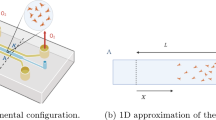Abstract
Chemotaxis is the biological process whereby a cell moves in the direction in which the concentration of a chemical in the fluid medium surrounding the cell is increasing. The chemical signal may be secreted by cells to signal other nearby cells (or clusters of cells) so that they can combine to form larger clusters. In a full simulation, spread of the chemical signal is modelled using the convection-diffusion equation which can be solved using the finite element method. This can then be coupled to a boundary integral model of the fluid motion due to the motion of the cells. However, the use of the finite element method to model the spread of the chemical is computationally expensive as the finite element approximations to some of the terms in the equations need to be recalculated at each time step as the relative velocities of the cells change. This can be avoided by adopting a simple explicit formula for the concentrations of the secreted chemical and allowing this to move with the cell that is emitting the signal. This paper will present some numerical results to show how the proposed model can be used to determine the motion of the cells with a much small computational cost when compared to the full coupled finite element method, albeit at the cost of losing some of the accuracy in the calculated concentrations of the chemical.
Access this chapter
Tax calculation will be finalised at checkout
Purchases are for personal use only
Similar content being viewed by others
References
Atkinson, K.E.: An Introduction to Numerical Analysis, 2nd edn. Wiley, New York (1989)
Beer, G., Smith, I.M., Duenser, C.: The Boundary Element Method with Programming. Springer, Vienna (2008)
Chertock, A., Kurganov, A., Wang, X., Wu, Y.: On a chemotaxis model with saturated chemotactic flux. Kinet. Relat. Model 5, 51–95 (2012)
Crank, J., Nicolson, P.: A practical method for numerical evaluation of solutions of partial differential equations of the heat-conduction type. Math. Proc. Camb. Philos. Soc. 43, 50–67 (1947)
Deleuze, Y., Chiang, C., Thiriet, M., Sheu, T.W.H.: Numerical study of plume patterns in a chemotaxis-diffusion-convection coupling system. Comput. Fluids 126, 58–70 (2016)
Elliott, C.M., Stinner, B., Venkataraman, C.: Modelling cell motility and chemotaxis with evolving surface finite elements. J. R. Soc. Interface 9, 3027–2044 (2012)
Gajewski, H., Zacharias, K.: Global behaviour of a reaction - diffusion system modelling chemotaxis. Math. Nachr. 195, 77–114 (1998)
Green, E.R., Mecsas, J.: Bacterial secretion systems: an overview. Microbiol. Spectr. 4, 1–19 (2016)
Harris, P.J.: A simple mathematical model of cell clustering by chemotaxis. Math. Biosci. 294, 62–70 (2017)
Harris, P.J.: Modelling the motion of clusters of cells in a viscous fluid using the boundary integral method. Math. Biosci. 360, 141–152 (2018)
Harris, P.J.: A combined boundary element and finite element model of cell motion due to chemotaxis. In: Constanda, C., Harris, P.J. (eds.) Integral Methods in Science and Engineering: Analytic Treatment and Numerical Approximations, pp. 163–172. Birkhäuser, Basel (2019)
Hoeller, O., Kay, R.: Chemotaxis in the absence of pip3 gradients. Curr. Biol. 17, 813–817 (2007)
Islam, S., Zaman, R.: A computational modeling and simulation of spatial dynamics in biological systems. Appl. Math. Mod. 40, 4524–4542 (2016)
Keller, E.F., Segel, L.A.: Model for chemotaxis. J. Theor. Biol. 30, 225–234 (1971)
Laganenka, L., Colin, R., Sourjik, V.: Chemotaxis towards autoinducer 2 mediates autoaggregation in Escherichia coli. Nat. Commun. 7, 13979 (2016)
Lapidus, I.R., Schiller, R.: A mathematical model for bacterial chemotaxis. Biophys. J. 14, 825–834 (1974)
Lighthill, M.J.: An Informal Introduction to Theoretical Fluid Mechanics. Clarendon Press, Oxford (1986)
Malawista, s., Chevance, A., Boxer, L.: Random locomotion and chemotaxis of human blood polymorphonuclear leukocytes from a patient with Leukocyte Adhesion Deficiency-1: normal displacement in close quarters via chimneying. Cell Motil. Cytoskeleton 46, 183–189 (2000)
Mazumdar, J.: The mathematics of diffusion. In: An Introduction to Mathematical Physiology and Biology. Cambridge University Press, Cambridge (1999)
Nitta, N., Tsuchiya, T., Yamauchi, A., Tamatani, T., Kanegasaki, S.: Quantitative analysis of eosinophil chemotaxis tracked using a novel optical device–TAXIScan. J. Immunol. Methods 320, 155–163 (2007)
Pozrikidis, C.: Boundary Integral and Singularity Methods for Linearized Viscous Flow. Cambridge Texts in Applied Mathematics. Cambridge University Press, Cambridge (1992)
Ritter, J., Klar, A., Schneider, F.: Partial-moment minimum-entropy models for kinetic chemotaxis equations in one and two dimensions. J. Comput. Appl. Math. 306, 300–315 (2016)
Zienkiewicz, O.C., Taylor, R.L.: The Finite Element Method, 4th edn. McGraw-Hill Book Company Europe, London (1989)
Acknowledgements
The author would like to thank Matteo Santin from Brighton Centre for Regenerative Medicine and Devices for his help and advice with some of the biological aspects of this work.
Author information
Authors and Affiliations
Corresponding author
Editor information
Editors and Affiliations
Rights and permissions
Copyright information
© 2020 Springer Nature Switzerland AG
About this chapter
Cite this chapter
Harris, P.J. (2020). The Mathematical Modelling of the Motion of Biological Cells in Response to Chemical Signals. In: Constanda, C. (eds) Computational and Analytic Methods in Science and Engineering. Birkhäuser, Cham. https://doi.org/10.1007/978-3-030-48186-5_8
Download citation
DOI: https://doi.org/10.1007/978-3-030-48186-5_8
Published:
Publisher Name: Birkhäuser, Cham
Print ISBN: 978-3-030-48185-8
Online ISBN: 978-3-030-48186-5
eBook Packages: Mathematics and StatisticsMathematics and Statistics (R0)




